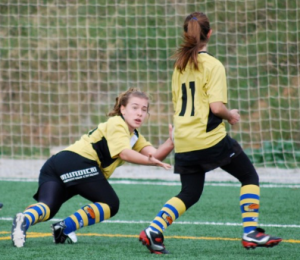Make Protective Eyewear Part of Your Uniform
- March 3
- Evans/Reilley
- Personal Injury
 While no gear can offer 100 percent protection, athletes are expected to wear all kinds of special equipment intended to improve safety. There are shin guards for soccer players, shoulder pads for football players, gloves for baseball players. Yet, protection of the eye, one of the most important and most vulnerable body parts, is often overlooked.
While no gear can offer 100 percent protection, athletes are expected to wear all kinds of special equipment intended to improve safety. There are shin guards for soccer players, shoulder pads for football players, gloves for baseball players. Yet, protection of the eye, one of the most important and most vulnerable body parts, is often overlooked.
In an effort to raise awareness and help people preserve their sight, the American Academy of Ophthalmology has designated April as Sports Eye Safety Month. Prevent Blindness America, the nation’s leading volunteer eye health and safety organization, has done the same for the month of September. Regardless of the date on the calendar or the sponsoring organization, it’s never a bad time to discuss the importance of proper eye protection while participating in sports.
While the risk of eye injury varies depending on the activity, it is estimated that there are more than 600,000 sports-related eye injuries annually. Approximately 42,000 of those injuries are serious enough to require a visit to the emergency room.
Studies show that most eye injuries among kids aged 11 to 14 occur while playing sports and that sports-related eye injuries account for more than 100,000 visits to the doctor every year at a cost of more than $175 million. Like the pace of the game itself, an accident can occur very quickly and result in ocular injuries such as corneal abrasions, inflamed irises, fractures of the eye socket, swollen retinas, detached retinas, traumatic cataracts, and permanent vision loss.
Eye protection is most important for those sports that involve high-speed balls, swinging clubs or bats, or close aggressive play. For example, basketball games can result in serious eye injuries caused by fingers and elbows of the other players. Each year, basketball is responsible for more than 2,500 eye injuries in children aged 5 to 14, and 32 percent of eye injuries in those aged 15 to 24. Certainly baseball pitchers can throw balls dangerously fast. Even those in Little League may be able to achieve speeds of 70 mph, though errant pitches aren’t the only possible problem. Trying to catch a ball lost in the sun, being hit by a thrown bat or colliding with a player’s cleat when sliding into base are just some of the scenarios that may partly explain why it has been estimated that 1 in 50 Little League players will sustain an eye injury that requires attention.
Although eye protectors cannot eliminate the risk of injury, appropriate protective eyewear has been found to reduce the risk of significant eye injury by around 90 percent when properly fitted. The safest lenses are those made of polycarbonate, which is 10 times more impact resistant than other plastics. For example, one study found that tennis balls propelled at 40 mph shattered high-index plastic lenses, while balls at 55 mph shattered allyl resin plastic lenses and those at 89 mph shattered glass lenses. Even at 89 mph, polycarbonate lenses did not shatter.
Choices for athletic eyewear feature a number of useful designs, such as being made from materials that absorb UV rays, reduce glare, resist shattering, resist scratching, enhance depth perception, keep side light out, reduce fogging, and repel dirt, water and sweat. The best protectors are those that have been approved by the American Society of Testing and Materials (ASTM). Approval means that the eyewear has been performance tested to make sure that it offers effective protection. One of the tests for sports lenses involves shooting balls at various speeds at the eyewear to be certain it can withstand the impact without touching the wearer’s face, breaking or distorting.
Many people who wear glasses every day don’t think they need anything different when participating in sports. However, prescription eyeglasses do not offer adequate protection and can even increase the risk or severity of an eye injury because they are prone to shattering. Instead, individuals who need corrective eyeglasses should wear polycarbonate lenses in a sports frame that passes ASTM F803 for the specific sport or an over-the-glasses eye guard that conforms to the specifications of ASTM F803 for sports in which an ASTM F803 protector is sufficient. Wearing a helmet, faceguard or sunglasses is also insufficient because your eyes are still exposed to blunt and penetrating injuries.
The state of New Jersey addressed this issue when it passed a law in 2006 mandating that any child who wears corrective eyeglasses must wear approved protective sports glasses when playing “racquetball, squash, tennis, women’s lacrosse, basketball, women’s field hockey, badminton, paddleball, soccer, volleyball, baseball or softball, sponsored by a school, community or government agency.” The law includes a grant provision to help low-income families buy the eyewear. Unfortunately, this legislation has no bearing on children who do not wear prescription eyeglasses or contact lenses, and the idea has not spread to other states. In fact, few youth sports leagues, schools, or teams require players to use protective eyewear.
If an eye injury does happen:
- Flush the eye with water only if there is small debris in it. Do not wash it out if there are cuts or punctures. Don’t try to rub anything out.
- Hold a cloth over the eye to protect it from further damage.
- Bandage any cuts around it to prevent infection.
- Use a cold compress to reduce swelling, but do not apply pressure.
- See a doctor or eye care professional as soon as possible. Even a soft blow can result in significant damage.
Eye injuries can be serious and life-altering. An eye accident can happen in a split-second and carry lifelong consequences. Please consider adding protective eyewear to your uniform every time you play and be a role model for younger athletes who may be preoccupied with appearance instead of safety. There is nothing cool about permanent blindness. If you have received an eye injury while playing a sport, you may wish to contact a personal injury attorney who can review your case and advise whether you have grounds to seek financial compensation.
About the Author
David Mann is a personal injury attorney at The Mann Law Firm in Macon, Georgia, which has been in the business of helping Middle Georgia residents for more than 50 years. A member of the Georgia Trial Lawyers Association, he is an experienced plaintiffs’ lawyer who honed his skills doing insurance defense work. Having practiced on both sides of the legal process gives him a unique perspective that can be very valuable to his clients.

 Serving Clients Throughout Texas
Serving Clients Throughout Texas
 Chip Evans is a partner at Evans & Herlihy. Chip brings to the firm more than 20 years of experience as a trial lawyer representing Plaintiffs. It is the desire to help individuals, not corporations, that attracts Chip to this side of the docket. [
Chip Evans is a partner at Evans & Herlihy. Chip brings to the firm more than 20 years of experience as a trial lawyer representing Plaintiffs. It is the desire to help individuals, not corporations, that attracts Chip to this side of the docket. [